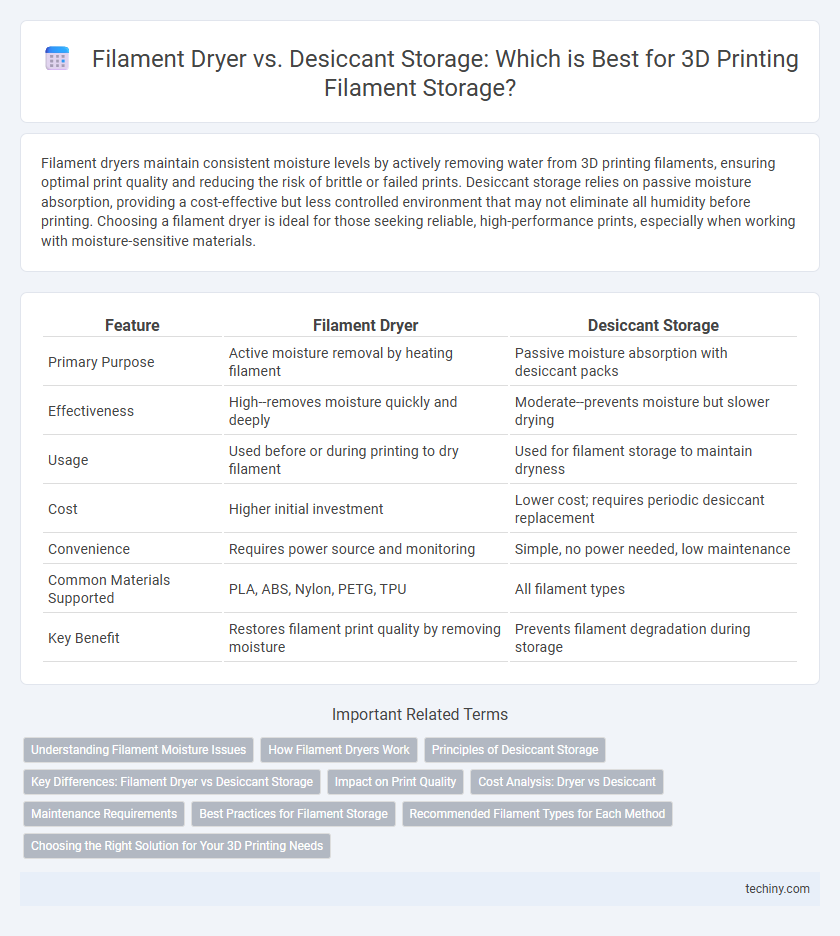Filament dryers maintain consistent moisture levels by actively removing water from 3D printing filaments, ensuring optimal print quality and reducing the risk of brittle or failed prints. Desiccant storage relies on passive moisture absorption, providing a cost-effective but less controlled environment that may not eliminate all humidity before printing. Choosing a filament dryer is ideal for those seeking reliable, high-performance prints, especially when working with moisture-sensitive materials.
Table of Comparison
| Feature | Filament Dryer | Desiccant Storage |
|---|---|---|
| Primary Purpose | Active moisture removal by heating filament | Passive moisture absorption with desiccant packs |
| Effectiveness | High--removes moisture quickly and deeply | Moderate--prevents moisture but slower drying |
| Usage | Used before or during printing to dry filament | Used for filament storage to maintain dryness |
| Cost | Higher initial investment | Lower cost; requires periodic desiccant replacement |
| Convenience | Requires power source and monitoring | Simple, no power needed, low maintenance |
| Common Materials Supported | PLA, ABS, Nylon, PETG, TPU | All filament types |
| Key Benefit | Restores filament print quality by removing moisture | Prevents filament degradation during storage |
Understanding Filament Moisture Issues
Filament moisture issues in 3D printing cause poor print quality, such as stringing and layer separation, due to absorbed water vapor. Filament dryers actively remove moisture by heating and circulating air, ensuring optimal filament dryness before printing. Desiccant storage passively absorbs humidity during filament storage but may not effectively combat moisture in already damp filament.
How Filament Dryers Work
Filament dryers operate by circulating warm air around the 3D printing filament to remove moisture absorbed from the environment, preventing print defects such as bubbles and weak layers. These devices maintain an optimal drying temperature, typically ranging between 40degC and 70degC, ensuring the filament remains pliable without degrading its properties. Unlike passive desiccant storage, which only absorbs humidity over time, filament dryers actively expedite moisture removal, improving the quality and reliability of 3D prints.
Principles of Desiccant Storage
Desiccant storage operates on the principle of moisture absorption, utilizing materials like silica gel or molecular sieves to capture and hold water vapor from the environment, thereby preventing filament degradation. This method maintains low humidity levels around 3D printing filaments, crucial for materials such as nylon or PETG that are highly hygroscopic. By creating a controlled dry environment, desiccant storage extends filament shelf life and ensures consistent print quality by reducing issues like bubbling or poor layer adhesion caused by moisture.
Key Differences: Filament Dryer vs Desiccant Storage
Filament dryers actively remove moisture from 3D printing filament using controlled heat, ensuring optimal filament quality and print performance. Desiccant storage relies on passive moisture absorption through silica gel or other desiccants, which requires regular replacement or reactivation to maintain effectiveness. Filament dryers provide consistent drying during printing, while desiccant storage primarily serves as a protective environment when the filament is not in use.
Impact on Print Quality
Filament dryers maintain optimal moisture levels in 3D printing filament by actively removing absorbed water, preventing issues like bubbling, stringing, and poor layer adhesion that degrade print quality. Desiccant storage passively absorbs ambient moisture but may be insufficient in highly humid environments, allowing filament to retain moisture that causes inconsistent extrusion and weak prints. Consistent filament dryness achieved by filament dryers leads to more reliable extrusion, smoother surface finishes, and higher dimensional accuracy in 3D printed objects.
Cost Analysis: Dryer vs Desiccant
Filament dryers generally require a higher initial investment ranging from $100 to $300, but offer consistent moisture removal and improved print quality, potentially reducing failed prints and material waste. Desiccant storage is a more cost-effective option with lower upfront costs around $10 to $50, but may need frequent replacement of desiccant packets and careful monitoring to maintain filament dryness. Over time, the total cost of maintaining filament quality could be higher with desiccants due to recurring expenses, while filament dryers provide a more reliable and long-term solution despite the higher upfront cost.
Maintenance Requirements
Filament dryers require regular monitoring of temperature settings and periodic replacement or regeneration of drying materials to ensure optimal moisture removal. Desiccant storage involves less frequent maintenance, primarily consisting of replacing or recharging desiccant packets to maintain low humidity levels. Both methods demand consistent attention to prevent filament degradation, but filament dryers typically require more active maintenance for effective operation.
Best Practices for Filament Storage
Maintaining optimal filament moisture levels is critical in 3D printing to ensure print quality and prevent nozzle clogging. Filament dryers actively reduce moisture by circulating warm air, offering a faster and more controlled solution compared to passive desiccant storage, which relies on absorbing ambient humidity over time. Using airtight containers combined with silica gel packs maximizes filament longevity, but integrating a filament dryer before use achieves the best results for consistent extrusion and surface finish.
Recommended Filament Types for Each Method
Filament dryers are highly recommended for moisture-sensitive materials such as Nylon, PVA, and TPU, which absorb water quickly and require consistent, high-temperature drying to maintain print quality. Desiccant storage is ideal for less hygroscopic filaments like PLA and ABS, providing prolonged moisture control without active heating, preserving filament integrity during storage. Choosing the appropriate drying or storage method prevents filament brittleness and surface imperfections caused by moisture absorption.
Choosing the Right Solution for Your 3D Printing Needs
Filament dryers use controlled heat to rapidly remove moisture from 3D printing filaments, ensuring optimal print quality and reducing warping or bubbling defects common with damp materials. Desiccant storage relies on moisture-absorbing agents like silica gel packs to maintain a dry environment during filament storage, preventing humidity-related filament degradation over time. Selecting between a filament dryer and desiccant storage depends on printing frequency, filament type, and environmental conditions, with dryers suited for immediate moisture removal and desiccants ideal for long-term filament preservation.
Filament Dryer vs Desiccant Storage Infographic

 techiny.com
techiny.com